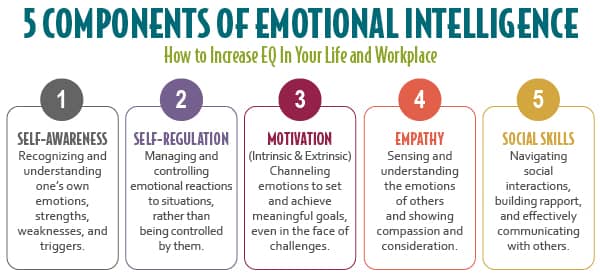If you’re in customer service, you’re familiar with customers waiting on hold, agents swamped with calls, and navigating challenging customer emotions. Unfortunately, those calls can end in apparent dissatisfaction. See how empathy can transform your customer service!
Estimated reading: 7 minutes

Heartmanity is proud to partner with outstanding companies that we wholeheartedly recommend so this post may contain affiliate links. This means if you click on a link and purchase something, we will receive a commission at no extra cost to you. Thank you for supporting Heartmanity's mission!
What if you...
- KNEW exactly how to diffuse intense customer emotions?
- Understood your customer without defensiveness?
- Had no need to constantly reiterate company policies?
- Could make a customer feel heard and valued?
- Left your customer service interactions feeling pleased?
I'll bet that would make your job a whole lot easier and much more enjoyable.
That’s what empathy is about—you totally get where someone’s coming from!
Transform the Way You Do Business with the Magic of Empathy!
When customer service responds with genuine empathy, people notice. Customers are satisfied—sometimes becoming raving fans! Trust and rapport skyrocket.
In one company I trained at, their call rate was approximately 200+ daily calls with a minimum of 7-12 minutes on the phone per customer. The high volume and long phone calls were costing the company thousands every week! But more importantly, customers left the phone angry; agents were discouraged and exhausted.
When I work with customer service departments, most agents are unaware that they are the problem, not the customer or the complaint.
It’s easy to get defensive, especially when a customer is wielding unrealistic requests, telling you something you know to be false or sounding absurd! The misstep most agents make is trying to correct erroneous thinking (who wants to be proven wrong!?). Instead of diffusing strong emotions, agents frequently lead with company policies that frustrate customers even more.
After teaching empathy (with a bit of resistance from agents initially, I must admit), the call rate dropped dramatically, and most calls were completed with happy customers in 3 minutes.
That’s the magic of empathy!
The real difference isn’t in service or product quality but in the warmth and understanding of human connection. Empathy leaves an indelible impact on customer service.
Cultivating it in your company will lead to happier customers and a thriving business. It’s time to reimagine customer service, not as a series of transactions but as a dance of human emotions woven with care, understanding, and genuine connection.
Welcome to a world where every call, every interaction, is a step closer to building lasting relationships and returning customers.
Imagine if you weren’t just answering questions and solving problems. Treating people with care and understanding—that’s the secret sauce. It’s not about selling stuff or fixing problems; it’s about making a friend on the other end of that call.
Dive deeper: "27 Best Ways to Raise Emotional Intelligence in the Workplace."
Empathy in Customer Service: Increase Success and Happier Customers with Empathetic Customer Service
In today’s rapidly changing business landscape, customer service remains the heart and soul of any enterprise.
Yet, the best product or service is frequently severely undermined by subpar customer interactions.
Just last week, I was on the phone with customer service with a website that wasn’t allowing me to redeem reward points to save me substantial money. The agent tried to minimize my complaint and justify the inconvenience.
Everyone’s experience is legitimate regardless of how irrational or ridiculous it may seem to someone else.
In my two decades of teaching empathy and emotional intelligence in the workplace, I’ve noticed a consistent pattern: organizations that understand and harness the power of empathy achieve outstanding outcomes.
But what does it mean to be “empathetic” in a customer service setting?
How can emotional intelligence transform your interactions, fostering happier customers and a thriving business?
Let’s dive deeper into the underappreciated nuances of emotional intelligence. We’ll uncover how empathy in your customer service approach can revolutionize how you connect with your customers, bringing unparalleled success.
The Heartbeat of Emotional Intelligence: Empathy
There’s a great saying to illustrate empathy, “To understand another person, you must swim in their sea, not just look at their waves.” This quote encapsulates the essence of empathy, which is a cornerstone skill of emotional intelligence. Customer agents tend to get caught up in the waves—the words and behaviors of those they serve. Or a tidal wave hits them, and they find themselves ill-equipped.
But what IS empathy?
Empathy isn’t just about understanding someone’s feelings; it’s about feeling with them. It’s the subtle difference between saying, “I understand you’re upset,” versus “I can feel your pain, and I genuinely want to help.”
What do you think when you’re upset, and someone says, “I understand”? Most people are thinking, “You don’t have a clue how I feel!”
Even so, this is a common response that often incites more frustration because the intention behind it is generally to move on to a solution. The undercurrent says, “Stop making such a big deal about this.”
How Empathy Redefines Customer Service
Empathy is not just a script or a Band-Aid for complaints. It is matching a communication style that connects with the other person. Below are ways empathetic customer service can transform your company’s interactions.
 Empathy humanizes the conversation.
Empathy humanizes the conversation.
Customers are not just ticket numbers in a system. They are individuals, each with their own stories, frustrations, and hopes. By practicing empathy, we recognize and validate their humanity, turning a potentially tense interaction into a meaningful connection.
 Empathizing with a customer diffuses intensified emotions.
Empathizing with a customer diffuses intensified emotions.
When a customer feels heard and understood, their defensive walls lower. Empathy can quell anger, soothe frustrations, and build trust, all critical in navigating challenging conversations. Until heated emotions are calmed, your customer will not be able to respond logically. All resolution depends on understanding.
 Empathy fosters loyalty, trust, and confidence in your company.
Empathy fosters loyalty, trust, and confidence in your company.
Customers remember how they’re made to feel. An agent who demonstrates genuine empathy can turn a disgruntled customer into a brand advocate. This authentic connection is not a mere business strategy—it’s developing long-lasting and authentic relationships. In today’s market, these connections are valuable!
I remember one instance with a company I worked with on skill-building. The advertising firm printed a competitor's logo on their client's full-page ad. Of course, they were furious and ready to drop them immediately. However, the CEO called them directly and empathized, taking full accountability. He was so impressed with the resilient response that they not only stayed on as a customer but increased their advertising budget.

Build Your Empathy Muscles
Cultivating empathy is like flexing and exercising a muscle—the more you use it, the stronger it gets. The stronger the empathy muscle becomes, the more natural it is and imprinted with the unique personality of each agent. A powerful ally!
Ways to Increase Your Empathy Skills
Here are some ways to develop and strengthen your empathetic ability. When these are practiced while considering the unique values and vision of the company, they can do wonders in enhancing client relationships, our greatest resource!
 Active Listening
Active Listening
Give your undivided attention. Whatever you do, don't multi-task. There is no way you can truly empathize when your attention is divided. You'll miss the subtle nuances, and your response will be disjointed. And instead of formulating a response while the customer is still speaking, truly listen. It’s in the pauses, the sighs, and the tone where empathy finds its greatest discoveries.
 Avoid Assumptions
Avoid Assumptions
Each individual is a private and complex universe.
Assume nothing.
Ask open-ended questions to provide insight into a customer’s feelings and motivations. Getting curious will provide you with key information you never dreamt possible.
 Give Reflective Feedback
Give Reflective Feedback
This technique involves mirroring back what you’ve heard, not like a parrot, but genuinely reflecting back the tone, context, and meaning to the customer. It not only ensures you’ve grasped the core issue but will also signal to the customer that they’re being heard.
Implementing empathy into customer service isn’t merely a soft skill or a “nice-to-have” talk sheet. It’s an alchemy that pervades your company and transforms ordinary interactions into memorable ones. These daily exchanges create a ripple effect of positivity for the customers, your customer service department, and the business.
As we explore deeper facets of emotional intelligence, it will become clear that in attuned human interactions, empathy is the melody that lingers.
For a deep dive into empathy: "The Three Kinds of Empathy: Emotional, Cognitive, and Compassionate."
Navigating Emotions: The Emotional Intelligence Compass
Imagine if our emotions came with a manual. Well, while there isn’t a handbook handed out at birth, emotional intelligence (or EQ) offers a map to understanding, interpreting, and acting upon emotions—both ours and those of others.
The Four Quadrants of Emotional Intelligence (EQ)
EQ isn’t a single entity but a composite of various skills. Picture it as a compass guiding us through the turbulent seas of human emotions and interactions:
Self-awareness: It’s the anchor. Recognizing your own emotions, understanding their origin, and seeing their impact is paramount. For customer service reps, this means being in tune with frustration or impatience and finding ways to recalibrate in real time.
Self-management: Equipped with self-awareness, this is about steering your emotional ship. It’s choosing calm over chaos and solution over stagnation, especially when a customer conversation takes a challenging turn.
Social Awareness: This is empathy’s close cousin. It’s about picking up on collective moods in group settings—like sensing the team’s morale or gauging a customer’s underlying needs from their tone or choice of words.
Relationship Management: This is the art of building and nurturing positive relationships. In a customer service setting, it translates to conflict resolution, effective communication, and creating lasting positive impressions.
See the chart below for a quick overview of the different EQ components.

Emotional Intelligence: More Than Just “Being Nice”
One might argue, “Isn’t EQ just about being polite?” While elements of emotional intelligence certainly overlap with being kind-hearted, it’s more strategic and actionable. It's not just about being nice; we must be firm and kind.
Emotionally Intelligent Responses
Let’s say a customer vents their frustration. A typical response might be, “I’m truly sorry you feel this way.” However, people actually don't want us to feel sorry; they want to feel heard and understood. An emotionally intelligent response dives deeper: “That sounds very frustrating! It's completely understandable you’d feel this way. Let’s find a way to resolve this together.”
Anticipating Needs
EQ gives reps a sixth sense of sorts. By being attuned to emotions, one can often anticipate a customer’s needs or concerns, offering solutions before they escalate into problems.
Building Emotional Resilience
Reps face a myriad of emotions daily. EQ equips them with resilience, allowing them to bounce back from challenging interactions more swiftly, ensuring each customer gets the best version of the representative.
Harnessing emotional intelligence isn’t about suppressing genuine human feelings. On the contrary, it’s about understanding and using them to create positive outcomes.
For those in customer service, mastering EQ is like having a secret weapon, turning potential confrontations into collaborative resolutions.
As we dive further into the intricacies of emotional intelligence, remember: it’s not about making every call perfect; it’s about making every interaction count. The goal is NOT to get off the phone as fast as you can; the goal is to create a connection that speeds up every call because of trust and resonance.

Responding with Empathy: How to Diffuse Intense Emotions
In the high-pressure world of customer service, you’ll often find yourself face-to-face (or voice-to-voice) with an upset customer expressing intense emotions. When tensions run high, the gift of empathy becomes your guiding star.
So, how can you employ empathy in practical ways to bring a sense of calm to stormy customer interactions? Let’s break it down with actionable steps and illustrative examples.
Empathy Statements in Customer Service
 Acknowledge their feelings.
Acknowledge their feelings.
Why: Before you dive into solutions, recognizing the customer’s emotional state helps them feel validated. If a customer is upset, they are operating from their reptilian brain and will not hear anything you say!
Empathy Statement Example #1:
Customer: “I’ve been transferred three times! No one seems to care about my issue!”
Empathetic Response: “Wow, that sounds extremely frustrating! I’m here now; let me give you my direct line in case we get disconnected. We’ll work through this together.”
 Maintain a calm and friendly tone.
Maintain a calm and friendly tone.
Why: Emotions can be contagious. Staying calm while matching the customer’s tone can lower emotional intensity and help set the overall temperature of the conversation.
Empathy Statement Example #2:
Customer: “This product broke in just a week! What kind of cheap stuff are you selling?”
Empathetic Response: (In a kind, unhurried tone) “How disappointing to order a product only to have it break a week later! Yikes! Let’s get this sorted out for you.”
 Mirror the customer's concern.
Mirror the customer's concern.
Why: By reflecting their concern, you show the customer you’re truly present and engaged in the conversation.
Empathy Statement Example #3:
Customer: “Every time I call, I’m put on hold forever!”
Empathetic Response: “It sounds like you’ve had a long wait, and that can be so exasperating. Let’s address your concerns right away.”
 Offer genuine apologies and reassurance.
Offer genuine apologies and reassurance.
Why: Apologizing can bridge the emotional gap, and reassurance offers encouragement and the hope of resolution. An apology lets the customer know that you are infallible and human, so typically, they cut you some slack and calm down more readily.
Empathy Statement Example #4:
Customer: “I’ve reported this issue twice, and nothing’s been done!”
Empathetic Response: “I genuinely apologize for this oversight. We appreciate you reporting the issue and taking the time to improve our service. Let me make sure we do right by you this time.”
 Ask open-ended questions.
Ask open-ended questions.
Why: Being curious encourages customers to share more about their feelings and the root cause of their frustrations. Sometimes what the complaint they start out with isn't the real issue. Once they know you're there for them, then they will risk going further.
Empathy Statement Example #5:
Customer: “Your service is just terrible!”
Empathetic Response: “You sound really upset! Swift and competent service must be important to you. Help me understand specifically how our service is falling short so we can act on your feedback."
 Show the customer that you’re taking action.
Show the customer that you’re taking action.
Why: Customers need to see that their concerns are being taken seriously and acted on. Words that don't match action cannot be trusted.
Empathy Statement Example #6:
Customer: “The last time I called your company, the representative promised a callback, which never happened. It’s been two days and I need an answer!”
Empathetic Response: “Oh no! As a valuable customer that is unacceptable. Let me resolve the matter right away.”
 Thank them for their patience and feedback.
Thank them for their patience and feedback.
Why: Acknowledging their patience can make customers feel valued.
Empathy Statement Example #7:
Customer: “I hope you can actually help me.”
Empathetic Response: “Thank you for being patient and bringing this concern to our attention. Let’s find the best way forward together.”
These empathy-fueled responses not only aim to soothe heightened emotions but also foster a collaborative environment where problems can be tackled head-on.
Here's a good analogy. Recently, I visited my bank, and the tellers wore Halloween costumes. Imagine that every upset customer is disguised with a Halloween mask, and your job is to discover the real person underneath that frustration or complaint.
Remove the mask to discover opportunities:
- Showcase your brand’s commitment to outstanding customer service.
- Make someone’s day!
- Build rapport through empathy.
- Promote a genuine human connection.
- Turn fleeting interactions into lasting relationships.
A Journey of Connection: Embracing Empathy in Every Interaction
In the tapestry of customer service, each thread represents a unique human interaction filled with emotions, challenges, and potential for connection.
One theme emerges: Empathy isn’t just a skill; it’s an art. It’s the art of truly seeing another, feeling with them, and creating an environment where problems aren’t just solved but relationships are nurtured.
While technology and processes have their place, it’s this human touch, this genuine intent to connect and understand, that leaves a lasting imprint on a customer’s heart. Every frustrated call, every dissatisfied customer, is a canvas waiting to be transformed with strokes of empathy and understanding.
So, where do you go from here?
Begin with self-awareness. Recognize your emotions, lean into them, and then channel them productively.
Listen—truly listen—to the stories, concerns, and feelings shared by your customers. Each call is more than just a query or a complaint; it’s an invitation to connect, empathize, and make a difference.
Closing Thoughts
If there’s one thing to carry forward from our conversation today, let it be this: Empathy isn’t just about making a customer happy for a moment; it’s about making an impact that lasts a lifetime.
I encourage you, no matter where you are in your customer service journey, to embrace empathy wholeheartedly—not just as a tool but as a philosophy. Dive deeper, explore further, practice daily, and witness the transformative power of genuine human connection in action. Because at the end of the day, it’s not about how many calls you’ve resolved but how many hearts you’ve touched.
If you'd like to apply empathy to your workplace culture, read, "Successful Businesses Are Lead by Solid Empathetic Culture."
Frequently Asked Questions
Why is empathy so important in customer service?
There may not be anything more important in customer service than empathy. Why? Because empathy allows us to put ourselves in the customer's shoes, helps others to feel heard, shows we value them, creates connection and resonance, and expedites solutions more quickly.
What is a lack of empathy in customer service?
Without empathy, most agents in customer service are annoyed at best in their jobs and customers are frustrated. When empathy isn't present, a customer service agent may resolve the issue, even quickly, but it's a one-time exchange. Of course, people like a problem is solved quickly; however, an agent rushing through can also feel like, "on to the next" and lack the human and compassionate element.
Lacking empathy is like rubber cookies instead of homemade chocolate chip cookies hot from the oven and smelling up the kitchen!
For customized training for teams in empathy or individual coaching, contact Jennifer at support@heartmanity.com.










